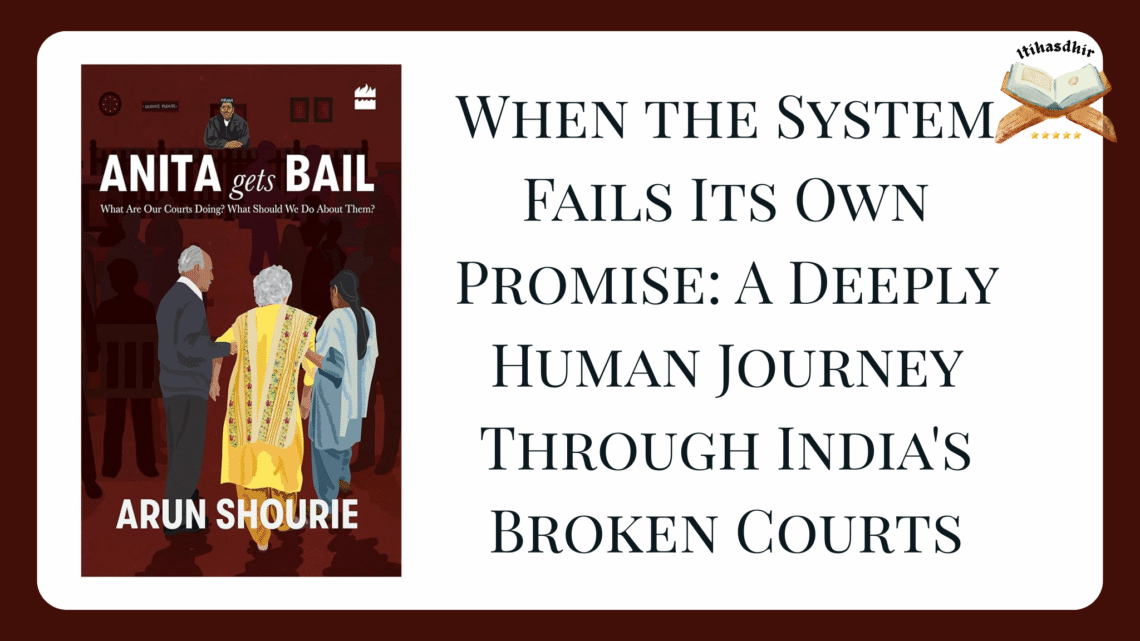
Justice or Farce? Analyzing When Anita Gets Bail by Arun Shourie
In a nation where justice is supposed to be blind but often appears blindfolded by incompetence, corruption, and callous indifference, Arun Shourie’s Anita Gets Bail emerges not as another academic treatise on judicial reform, but as a raw, deeply personal account of what happens when ordinary citizens collide with India’s labyrinthine legal system. This is judicial critique at its most human—written not from the ivory towers of legal scholarship, but from the waiting rooms of district courts where hope withers and dignity dies a slow death.
The Personal Becomes Political: A Love Letter to Resilience
What makes Shourie’s twenty-seventh book extraordinary is its foundation in lived experience. The narrative begins with a scene that could have been lifted from Kafkaesque nightmare: a policeman arriving at the doorstep asking for “Madam,” referring to Anita Shourie, the author’s wife who suffers from Parkinson’s disease. She stands accused of violating environmental regulations by constructing a house on land she never owned, a structure that was never built. The summons she allegedly evaded were never served.
This isn’t just legal incompetence—it’s institutional cruelty at its most refined. Shourie documents with painful precision how his ailing wife, already battling a degenerative neurological condition, was forced to navigate the chaos of Faridabad courts for six excruciating years. The image of a Parkinson’s patient waiting for hours in overcrowded courtrooms, only to have cases adjourned on frivolous grounds, becomes a metaphor for everything that has gone wrong with our promise of accessible justice.
Beyond the Personal: The Anatomy of Systemic Decay
Shourie’s genius lies in weaving this individual trauma into a broader indictment of institutional failure. Through meticulously documented case studies, he exposes how India’s courts have become playgrounds for the powerful and graveyards for the vulnerable. The book examines many Supreme Court rulings, presenting what one reviewer called “the good, bad, and ugly side of the Indian judicial system”.
The Jayalalithaa Case: How Power Games Justice
Perhaps the most damning illustration is Shourie’s analysis of the disproportionate assets case against former Tamil Nadu Chief Minister J. Jayalalithaa. Filed in June 1996, the case meandered through the courts for twenty-one years before the Supreme Court finally delivered its verdict in February 2017—after Jayalalithaa had already died.
The case became a masterclass in how the system can be gamed. When the matter reached the Karnataka High Court, the judge employed what Shourie describes as “arithmetic peculiarly his own” to inflate Jayalalithaa’s legitimate income and deflate her expenses, effectively legitimizing her disproportionate assets. The Supreme Court eventually restored the original trial court conviction, but by then it was too late—both for justice and for Jayalalithaa.
The Culture of Corruption: Justice Nirmal Yadav and the Rs. 15 Lakh Mistake
Shourie also documents the bizarre case of Justice Nirmal Yadav, who was allegedly offered a Rs. 15 lakh bribe to deliver a favorable judgment. The money was first mistakenly delivered to Justice Nirmaljit Kaur’s residence instead, only because someone misheard “Nirmalji” as “Nirmaljit”. Justice Kaur promptly called the police, leading to the arrest of the messenger and the exposure of the entire network. As Shourie notes, even the presumption that judges could be bought for a fee is enough to make the system’s reputation collapse.
This episode is emblematic of the ever-present shadow of bribery within the judiciary, casting a long doubt on the integrity of those tasked with upholding the law. It becomes even more disquieting when viewed alongside more recent developments, such as the Justice Varma case, where fresh allegations have highlighted ongoing vulnerabilities in judicial appointments and the expectation of judicial impartiality. These repeated scandals serve as warnings—every exposure further chips away at public trust and underlines the urgent need for meaningful reform to reclaim the judiciary as a true protector of justice.
The Human Cost of Institutional Failure
What emerges from Shourie’s narrative is not just a critique of legal procedures, but a profound meditation on human dignity under institutional assault. His wife’s ordeal becomes representative of millions of Indians who find themselves trapped in a system that was designed to protect them but has instead become a source of immense suffering.
The book reveals how the very institution meant to be the “last pillar standing” has become increasingly vulnerable to external pressures and internal frailties. Courts that should deliver justice instead preoccupy themselves with trivia while ignoring life-and-death reforms. Judges who should be paragons of legal knowledge display “laughable” understanding of basic scientific facts. The system has evolved into something “cold-hearted,” as former Chief Justice A.P. Shah observed at the book’s launch.
The Larger Canvas: Democracy Under Siege
Anita Gets Bail ultimately transcends its immediate subject matter to become a meditation on democratic institutions under authoritarian pressure. Shourie argues that the cracks in the judiciary—from compromised collegium appointments to mysterious judge transfers—provide dangerous opportunities for political rulers to suborn this last bastion of institutional independence.
His warning is particularly relevant in contemporary India, where questions about judicial independence have become increasingly urgent. The book serves as both historical record and prophetic warning about what happens when the “last dyke” protecting citizens from government excess begins to crumble.
A Call for Reckoning
In the end, Anita Gets Bail succeeds because it refuses to let readers remain comfortable spectators to institutional decay. Shourie’s personal anguish becomes a mirror reflecting our collective complicity in accepting substandard justice. His wife’s eventual bail—the book’s titular victory—feels less like triumph than like temporary reprieve from a system that remains fundamentally broken.
The book stands as both lament and rallying cry, demanding that citizens reclaim ownership of institutions that belong to them. It reminds us that behind every delayed judgment, every corrupt bargain, every mysterious transfer lies a human story of suffering that our indifference has made possible.
For anyone seeking to understand not just how India’s judiciary functions but how institutional failure translates into personal trauma, Anita Gets Bail offers an essential, unflinching account. It’s judicial criticism at its most urgent and most human—a book that transforms policy debates into moral imperatives and makes the abstract concrete through the simple, devastating power of one family’s encounter with injustice.

Aditya Saraff joined Itihasdhir in 2024 as a co-founder. A graduate who is pursuing CA, Aditya loves to read and research. As a writer dedicated to the niche of history and culture, he has written articles to raise awareness and tackle various issues related to the Bharatiya Civilisation and the Hindu community.





